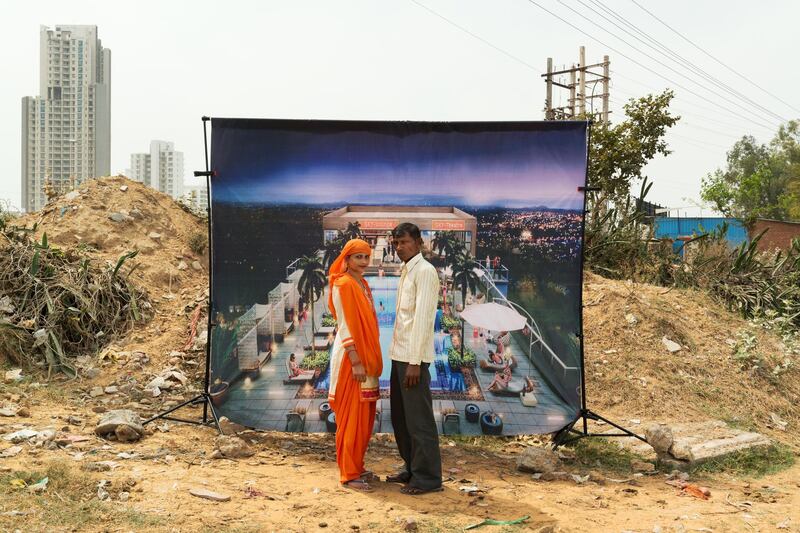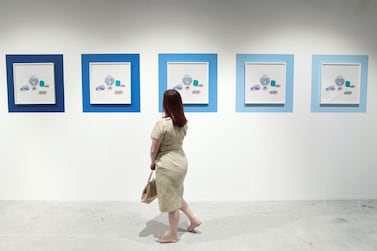Visions of Colombo flash on the screen – buildings old and new, railway stations, parking lots, beaches, rain puddles, places of worship – all taken on Abdul Halik Azeez’s smartphone. It is a visual diary of the artist’s life from the period of February to July 2016. Embedded in the visuals of this stop-motion ‘stream of consciousness’ video is the story of Sri Lanka’s urban transformation after the end of the country’s civil war in 2009.
It isn’t always easy to identify what we are seeing – the photos flit by so fast – but we can catch glimpses of beach resorts and commercial developments like the Majestic City shopping complex, interspersed with derelict houses, street vendors and quaint living rooms. There is a sense of intimacy in these images, especially since Azeez injects selfies and pictures with friends, that you begin to feel as if you know the artist, despite the fact that the 10-minute film is ultimately a digital construction.
What does begin to emerge is a contemplation on architecture and infrastructure, and how a person navigates these spaces on a daily basis. What do such structures say about history, representation, and our shared hopes? This question is present throughout the Ishara Art Foundation’s current exhibition Body Building, which features Azeez along with 15 other artists who work with photography.
The title is a play on words – body and building – meant to highlight man’s relationship to his built environment, specifically in the context of South Asia. The subcontinent and its links to the Gulf are the focus of the foundation, which opened in March. For curator Nada Raza, formerly at the Tate in London, it is vital to investigate these ties and see how bridges can be drawn between the two regions, and potentially other parts of the world.
“I have really been thinking about what this city [Dubai] means to us; what our attachments to it are; how, even when we go to what everybody calls ‘back home’, we carry this urban experience with us in some way, and also when we arrive here, we carry those cities with us. It’s about that exchange,” she explains.
When thinking about the relationship between South Asia and the Gulf, there is a longstanding history of exchange – of goods, of labour in the form of human bodies, but also of ideas flowing both ways. Consider Pramod Pati's 1968 film Six, Five, Four, Three, Two, which Raza calls the "heart of the show", a short film that depicts the ambitions of a pair of newlyweds as they set off to start a modern nuclear family in a new high-rise building. It reflects the drive towards progressive and modern values in 1960s India, when the country was beginning to liberalize trade. "If we look at South Asian families, that life is being lived here, but where were those ideas actually sown?," asks Raza.
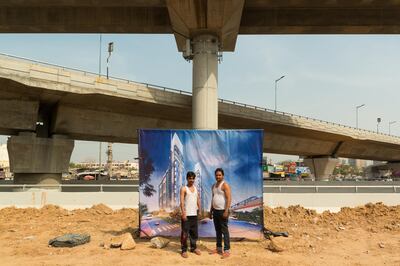
In contrast to the aspirations of the Pati’s characters are the subjects of Arthur Cresanti’s photographs. His series of works from Gurgaon, a suburb of Delhi juxtaposes the residents of the area with PVC banners of upcoming real estate projects. Here, the ideas move in the other direction – the ethos of hyper-development from the Gulf to South Asia. The couple in Cresanti’s staged portraits stand in front of a render of a rooftop pool lounge, with European models sitting on sunbeds. Yet behind this shimmering image are mounds of earth, shattered rocks and concrete. This disconnect between the promise of affluence and the reality of the city indicates how commercialism has trumped community.
“If you look at architecture, the way in which these buildings are advertised and sold, you realise that the inspiration is definitely related to the Gulf. But not just the Gulf, it is also China. The influences are across the board.” In this way, Raza is trying to “make a bridge”, seeing how these trends in urbanisation and globalisation tie our collective present and future together.
“Through the flows of capital, everything is connected,” says Raza. She describes how her biggest regret is being unable to make down payment for an apartment in London, where she lived for 15 years. “It’s interesting because [England] is a country where people went from the state providing housing, to people living on reasonable rents, to becoming a country of owners and landlords. That’s really where the body of post-Thatcher property ownership gets solidified.”
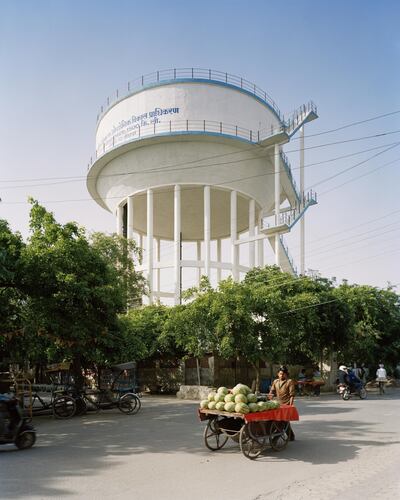
She adds that these ideas were in her mind when she moved to Dubai. “I was trying to understand for myself what happened with our parents’ generation and what is happening with ours,” she explains. Today, Pati’s vision of home ownership and modern family structures seems to have faded.
This does not mean that the exhibition is riddled with condemnations, but rather of questions on how these changes have affected the way we work and live. “It is not about good or bad. It is about trying to understand what we choose to keep and how we dream about what should be,” says Raza.
In Randhir Singh’s photographic series of water towers across New Delhi, he remembers a time when public infrastructure projects were prevalent in India. Now, these structures seem to serve as relics for this push towards modernisation in the country. The water tower is also an architectural symbol that has sentimental value in the UAE, particularly the tower in Al Safa’s Al Khazzan Park, which dates back to the 1960s.
While Singh looks at public structures, Vivek Vilasini turns to private spaces. His series Housing Dreams captures a phenomenon in Kerala, where migrants workers have turned away from traditional courtyard houses and materials to build homes of varying international styles. Vilasini's photographs show their vibrantly coloured facades, and when seen together side by side, produce a eye-catching display of collective aspirations.
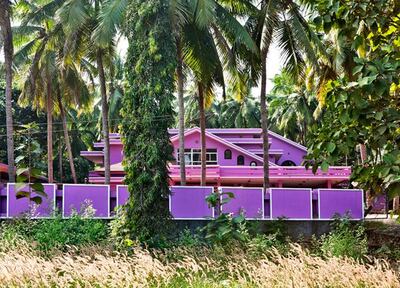
City life in India and parts of South Asia are ever-present throughout the show, as seen in the works of Ram Rahman and Pablo Bartholomew. “I wanted to bring people into the space of the South Asian street. When you look at Dubai, when you live here, when you look at who the pedestrians are, when you see who is walking down the street… It’s us. It’s people like me,” says Raza, who is from Pakistan. By drawing these parallels, she seems to show how urban life replicates or transforms itself as it crosses oceans.
In these spaces, notions of caste, class and gender also play out. In Rahman’s black and white photographs of Delhi streetscapes, men are more visible, not just in terms of physical presence, but symbolic presence as well, as posters of wrestlers are found across the city.
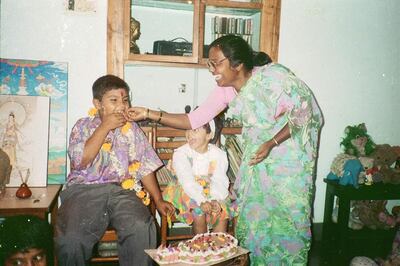
The personal archive of family photos from Rajyashri Goody show a different kind of presence. Born to a half-Dalit and half-English family, Goody understood the negative representations of Dalit communities in the public sphere. In India, the Dalit caste is considered the lowest status in Hindu social structure, and the community often faces discrimination in terms of access to education and healthcare. This has led to wide instances of segregation in parts of India, where Dalit people are shunned from community spaces and public areas. By sharing images from such intimate moments such as family dinners, the artist projects a more personal, human view of Dalit communities, but also reasserts their existence.
For Raza, it was important to face these issues – of architecture, urbanism and public spaces – in ways that did not seem reductive of their histories and contexts. “When you’re making shows that are trying to have social impact, you end up slipping into the tropes of social science,” she says. Her intent was to “move away from the narrative of the disenfranchised being victims, and instead look at the ways in which resistance and resilience take place.”
In Body Building, we see how architecture can bear the weight of history and political economy, and how this is passed on to the communities who live among these structures. Raza has put together a thoughtful exhibition that not only presents new ways of looking at the connections between the Gulf and South Asia, but also asks ever-more important questions about our relationship to our built environments, and whether its current trajectory is worth redirecting.
Body Building is on view at Ishara Art Foundation, Alserkal Avenue, until Saturday, December 14.
